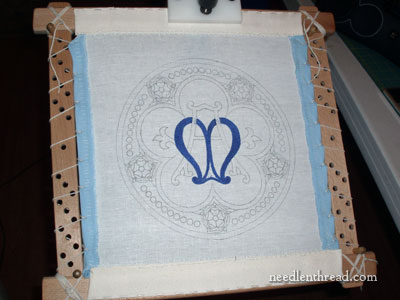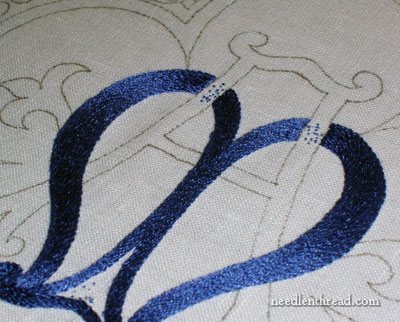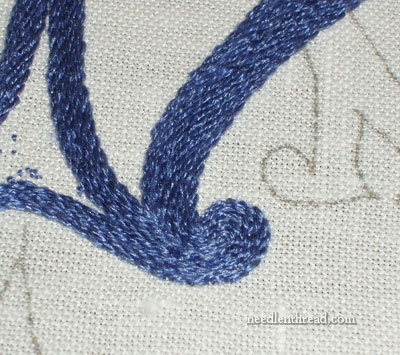This week, I’ve made a little progress on my Medallion project I showed you a couple weeks ago. It’s a commissioned piece of church embroidery that needs to be finished this coming spring. I’m shooting for February.
The piece goes quickly enough when there are good chunks of time to devote to it. I’ve got about 6 projects going right now, but this is a priority, so more time is spent on it than on the other projects… You know how it is!

This is the project from far away. Not too impressive, is it? That’s a lot of stem stitch, though, so I’m pleased that it’s this far along! The central “monogram” on the piece (an intertwined “A” and “M” which stand for “Maria” or “Ave Maria” depending on the source you read) will be solid color. The M (which is almost finished there in the middle) is worked in stem stitch with two strands of Soie d’Alger silk, in color #4914, I believe. The A will be worked in a slightly darker shade, and I’m contemplating working it in a tiny chain stitch filling, so that there’s a slight contrast in texture. Both letters will be outlined in gold.

Soie d’Alger is a spun silk, so it doesn’t have as high a sheen as filament silk, but it still has a very nice, subtle sheen.
The background behind the monograms will be worked in Soie Ovale in Brut, which is a not-white, not-off-white, kind-of-barely-champagne color. Soie Ovale is a flat filament silk, and over it, I’ll be working a tiny gold twisted thread in vermicelli work. I’m aiming for a definite contrast between the sheen of the Soie Ovale, the gleam of the gold, and the subtle sheen and texture of the solid embroidered letters.

Working into the smaller parts of the letters – especially the scrolled feet on the M – was a bit tedious. With stem stitch, as you work tight curves, the tighter the curve, the smaller your stitches should be. Anyway, these sections worked out ok, but they were a bit fiddly, and I’m not 100% keen on the way they came out. Still, in context of the whole piece, I think they’ll be fine.
So that’s my update on this project! As I go along, I’ll keep you informed on the materials & techniques involved, and share any tips that you might find useful for your own embroidery projects.
I hope you’re making progress on your projects these days, too! For some reason, October has been a Very Busy Month, hasn’t it?
If you’d like access to all the tips and techniques discussed in the Medallion Project, including complete step-by-step coverage of the Tudor-Style Rose, conveniently collected in one document, interlinked, referenced, and indexed, why not add the Marian Medallion Project e-book to your library? It’s packed full of all kinds of embroidery tips for undertaking a project like this, all in a convenient electronic format for easy searching.







It is beautiful so far. There is a very nice sheen, which looks like a shimmer from the pic. Will the tiny chains look too similar to the stem, in a deeper tone? Many of the antique monogrammings typically use substantially different stitch and color combinations, but you are such a talented designer that it will, I’m sure, be absolutely gorgeous altogether. Thanks for sharing!
Gorgeous Mary!!
Just wondering – the top tips of the m that will be covered partly by the A – why did you put small stitches (they look like seed stitches to me from here) there? Isn’t that section just going to be covered up anyway?
I love the stem stitch filling – you’ve done such a beautiful job!!
Hi, All – Thanks for your comments!
The little stitches in there are just anchor stitches. They’ll be completely covered.
The chain stitch will be a deeper color (just a shade darker) and a bit smoother than the stem stitch, but just as much “fill” – it’ll be solid. It probably won’t stand up as much as the stem stitch, but I’ll still be using two strands of the Soie d’Alger, so it should be similar in thickness. I’ll probably test it a bit first, to make sure it looks right…!
MC
Good morning Mary,
This is beautiful. Will you be adding this pattern to the ecclesiastical book patter?
Maria
Thanks, Alice! Thanks, Maria! Yes, Maria – this design is in the pattern book! ~MC
Beautiful stitching Mary and the sheen is gorgeous. I’m looking forward to watching this grow.
Mary,
It looks fabulous. Oh, to stem-stitch a tenth of that well would be a blessing indeed. How gorgeous the stitching is! Thank you for posting it.
Doris HH
What do you mean by ‘I’ll be working a tiny gold twisted thread in vermicelli work’? I googled it, but there is no description that I could find.
Lot of pasta, tho.
Wow it looks stunning! As much as we enjoy it there can be some tedium, yes 🙂
Thank you, I’m really enjoying following your project’s progress.
Mary– you are so awesome. I really admire your work and especially enjoy your explainations of things as it lets us see your reasoning for certain aspects of the project (for ex, today, that you are using different types of threads to emphasize the sheen and different stitches to emphasize the texture). I always learn something from your posts. Thanks for taking the time and effort to share.
Hugs, Dawn
Mary, This is beautiful already! I’m looking forward to reading about the process and seeing the finished product! Thanks for sharing.
Carla
Beautiful “M” Mary…can’t wait to see the “A”. I, too, love to work monograms and even figures in stem stitch and chain stitch. It seems to go fairly fast and give a really nice “filled” look to things. I’ll be watching to see this thing “grow”.
Tess
Yes, what is vermicelli work?
The blue catches the light beautifully, and having the slightly darker A will be lovely. It will be really fun to see this project as you progress in it.
I think the stem stitch looks beautiful in the curves. The sheen is really perfect too.
Mary as a newie to your page I am delighted to say I am glad I found it. What a wonderful list of needlecraft you enjoy and sharing it out is generous of you. I like I suppose many of my age learnt sewing young. I was 7. I was given a piece of brown paper and a big darning needle and told I was to do a straight stitch around a daisy picture and must follow the lines with no wobbles. When I could do that well, I might get to do it on a piece of cloth.
Needless to say it took a few pieces of brown paper. Practice I did. My family were excellent “needle” people even some of the men.
The saying that “if a job is worth doing, do it well, nothing else is good enough”. Took some living up to. But all the sewing get together were wonderful.
I am about to start tambour on netting and tambour beading. Haven’t done it in so long though. I never used anything flash like tambour needle holder. I used 2 corks and a crochet hook. I am thinking of betting abit flash and do the bought tambour tool thing. What I am finding hard at the moment here in Australia is buying beads on strings. I think French breads are a thing of the past. I hope that anyone who bothers to read my blathers will be able to suggest possible bead outlets in Australia and the next best beads to buy other that French.
I, like others of your readers look forward to seeing your work progress.
Thank you for an informative site.
Heart’s greetings to you and all.
Mary your stem stitch is divine. I love this thread for its lustre-not-shine and here it is gorgeous. I can’t wait to see the finished project.
On the subject of beads on strings for Denise in Australia: I don’t bother with trying to buy beads on strings, I am more concerned with the quality. For seed beads I believe Matsuno or Toho are the best but they aren’t ’round’. If you want round beads look for Czech glass. There are many places on line to buy good beads, sadly lots of them are in America which adds to the postage, but there are a couple – have a look at http://www.cranberrybeads.net.au. Apologies for this lengthy post.
Hi Mary,
This is so beautiful I love the color and the detailed work… Thank you for sharing
Hello
First i want to say i adore your site! thank you for making it not only enjoyable beyond words but easy to follow and comprehend. My question to you is: when working the letter ‘M’ on your medallion piece, does it matter if you work the stem stitch top to bottom or bottom to top? I would think I would worry about nicking the threads. Do you have any advice on this? How did you work the rows?
Thank you!
Hi, Jennifer – in the final piece, I didn’t actually use stem stitch. I used long and short stitch. When working stem stitch filling, it doesn’t really matter which direction you work in, as long as you are always doing stem stitch. The placement of the working thread in relation to the needle changes, depending on the direction you’re moving in. This is probably best explained by watching my stem stitch video. Hope that helps!
MC